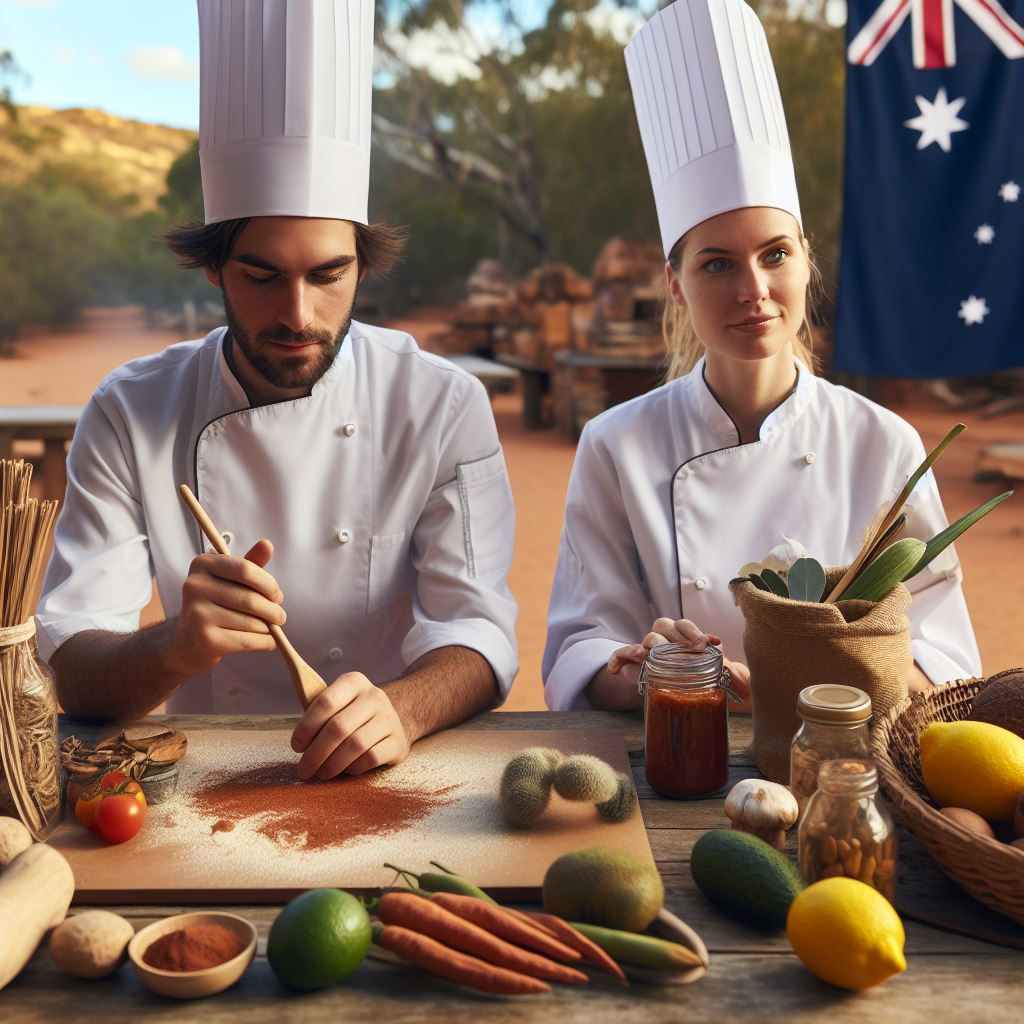Introduction
Cooking with Indigenous Australian ingredients has gained significant attention in recent years.
The unique flavors and cultural significance associated with these ingredients have piqued the interest of both professional chefs and home cooks alike.
In this blog post, we will explore the reasons behind this growing interest and delve into the main points of incorporating Indigenous Australian ingredients into our cooking repertoire.
One of the key factors contributing to the rise in popularity of Indigenous Australian cuisine is the increasing recognition of Indigenous cultures and their contributions to the culinary world.
People are becoming more aware of the rich history and traditions that have shaped these unique ingredients and are eager to incorporate them into their own cooking.
The distinct flavors and textures offered by Indigenous Australian ingredients provide a refreshing and exciting change from the usual pantry staples.
Ingredients like bush tomatoes, wattleseed, and lemon myrtle add a depth of flavor that can elevate any dish to new heights.
Another point of interest is the sustainability and ethical considerations associated with cooking with Indigenous Australian ingredients.
By supporting local Aboriginal communities, we can help preserve traditional knowledge and support sustainable practices that protect the land and its resources.
In this blog post, we will guide you through some essential Indigenous Australian ingredients and discuss how to incorporate them into your favorite recipes.
From exploring native herbs and spices to discovering traditional cooking methods and techniques, we aim to provide you with the knowledge and inspiration to embrace the flavors of Indigenous Australia in your own kitchen.
So, join us on this culinary journey as we celebrate the vibrant and diverse world of Indigenous Australian cuisine.
Get ready to expand your culinary horizons and embark on a flavorful adventure like no other.
Overview of Indigenous Australian Ingredients
In Indigenous Australian cuisine, a unique and diverse range of ingredients takes center stage.
These ingredients hold immense significance in Aboriginal culture and history.
Not only do they add flavor to dishes, but they also provide numerous health benefits.
Unique and Diverse Range of Ingredients
- Macadamia nuts: Known for their buttery texture and nutty flavor, they are a versatile ingredient.
- Quandong: These red fruits have a tart taste and are often used in desserts and sauces.
- Wattleseed: This seed is ground into flour and adds a coffee and chocolate-like flavor to dishes.
- Lemon myrtle: Its citrusy aroma and strong lemon flavor make it a popular ingredient.
- Emu: This lean meat is low in fat and rich in protein, making it a healthy choice.
- Kangaroo: Similar to emu, kangaroo meat is lean and packed with nutrients.
- Yam daisy: This root vegetable has a nutty taste and is often used in savory dishes.
Significance in Aboriginal Culture and History
Indigenous Australian ingredients have played a crucial role in Aboriginal culture and history for thousands of years.
These ingredients were traditionally sourced from the land and used in ceremonial and everyday cooking.
They symbolize the connection between the Aboriginal people and the land, embodying their spiritual beliefs and practices.
Health Benefits of Using Indigenous Australian Ingredients
Using Indigenous Australian ingredients in cooking not only adds flavor but also enhances the nutritional value of dishes.
Macadamia nuts are packed with healthy fats, vitamins, and minerals, promoting heart health and reducing inflammation.
Quandong is rich in antioxidants and Vitamin C, aiding in immune function and protecting against cell damage.
Wattleseed is a good source of protein, fiber, and minerals, contributing to satiety and supporting digestion.
Lemon myrtle contains essential oils that have antimicrobial and anti-inflammatory properties, benefiting overall health.
Lean meats like emu and kangaroo are high in iron, zinc, and omega-3 fatty acids, vital for optimal health.
Yam daisy is a low-glycemic food, providing sustained energy and aiding in blood sugar control.
Incorporating Indigenous Australian ingredients into modern cooking not only adds a unique twist but also honors the rich cultural heritage of the Aboriginal people.
Your Personalized Career Strategy
Unlock your potential with tailored career consulting. Get clear, actionable steps designed for your success. Start now!
Get StartedBy exploring and experimenting with these ingredients, we can appreciate their cultural significance while reaping their health benefits.
Next time you’re in the kitchen, consider adding a touch of Indigenous Australian flavor to your dishes and embrace the wonders of this ancient cuisine.
Popular Indigenous Australian Ingredients and Their Uses
In this section, we will explore a selection of popular Indigenous Australian ingredients and their various uses, including wattleseed, lemon myrtle, kangaroo meat, and bush tomatoes.
We will provide information on the taste profiles, nutritional value, and traditional uses of each ingredient, as well as include tips on where to source these ingredients for cooking.
Wattleseed
Wattleseed is a highly versatile ingredient widely used in Indigenous Australian cuisine. It has a unique nutty and roasted flavor profile that adds depth to both sweet and savory dishes. Rich in protein and fiber, wattleseed is a nutritious addition to any diet.
Traditionally, wattleseed was ground into flour and used in damper, a type of bread, as well as a base for thickening sauces and soups.
It is also used in desserts like ice cream, cakes, and pancakes. You can find wattleseed in specialty grocers or online stores that focus on Indigenous ingredients.
Lemon Myrtle
Lemon myrtle is a vibrant ingredient known for its strong, citrusy aroma and flavor. It adds a refreshing and zesty punch to various dishes.
This versatile herb is packed with antioxidants, vitamins, and minerals, making it a healthy choice.
Indigenous Australians have long used lemon myrtle for its medicinal properties, such as relieving indigestion and soothing coughs.
In cooking, it is commonly used in marinades, sauces, syrups, and desserts. Lemon myrtle can be found in specialty spice shops or ordered online from Indigenous ingredient suppliers.
Kangaroo Meat
Kangaroo meat is a lean and sustainable protein source that has gained popularity in recent years. It has a unique flavor profile, described as slightly gamey and similar to beef. Kangaroo meat is also low in fat and high in iron.
In Indigenous cuisine, kangaroo meat has been a staple for thousands of years. It is often prepared as a stew or grilled, and its versatility allows it to be incorporated into various dishes like stir-fries, pasta, and burgers.
Kangaroo meat can be purchased from specialty butchers or online meat suppliers.
Bush Tomatoes
Bush tomatoes, also known as desert raisins, are small fruits with a strong pungent flavor. They add a unique tangy and slightly sweet taste to both savory and sweet dishes. They are a good source of vitamins, antioxidants, and minerals.
Indigenous Australians have long used bush tomatoes in their recipes, including soups, sauces, stews, and chutneys. They can also be incorporated into bread, muffins, and desserts.
Bush tomatoes can be sourced from Indigenous-owned businesses, specialty grocery stores, or online suppliers.
By incorporating these Indigenous Australian ingredients into your cooking, you can create dishes that are not only flavorful but also pay homage to the rich culinary traditions of the First Nations people.
Explore the diverse tastes and nutritional benefits these ingredients offer by sourcing them from reputable suppliers and let your creativity flourish in the kitchen!
Read: Navigating COVID-19: Travel Agents’ Advice
Stand Out with a Resume That Gets Results
Your career is worth more than a generic template. Let us craft a resume and cover letter that showcase your unique strengths and help you secure that dream job.
Get HiredTraditional Indigenous Australian Recipes
Kangaroo Fillets with Bush Tomato Sauce
- Marinate kangaroo fillets with salt, lemon juice, and crushed garlic for 30 minutes.
- Prepare the bush tomato sauce by simmering bush tomatoes, garlic, onion, and water for 1 hour.
- Cook the marinated kangaroo fillets on a hot grill for 3-4 minutes on each side.
- Serve the fillets with a generous spoonful of bush tomato sauce on top. Enjoy!
Wattleseed Damper
- In a bowl, mix self-raising flour, wattleseed, salt, and sugar.
- Pour in warm water gradually, while stirring, until the dough comes together.
- Knead the dough on a lightly floured surface until smooth.
- Shape the dough into a round loaf and make shallow cuts on top.
- Bake the damper in a preheated oven at 180°C for 30-40 minutes, until golden brown.
- Serve it warm with butter or your favorite spread.
Lemon Myrtle Barramundi
- Coat barramundi fillets with lemon myrtle, salt, and pepper.
- Heat a pan with olive oil and sear the fillets for 3-4 minutes on each side.
- Remove the fillets from the pan and set aside.
- In the same pan, melt butter and sauté garlic and lemon juice.
- Pour the sauce over the barramundi fillets and serve with a side of seasonal vegetables.
Bush Tomato Chutney
- In a saucepan, heat olive oil and sauté onions until softened.
- Add bush tomatoes, brown sugar, apple cider vinegar, and water.
- Bring the mixture to a boil, then reduce the heat and let it simmer for 30 minutes.
- Stir occasionally to prevent sticking.
- Remove from heat and let the chutney cool before transferring it to sterilized jars.
- Once cooled, seal the jars and refrigerate. The chutney will keep for several months.
Personal Experience
One summer, during a camping trip in the Australian outback, I decided to try cooking recipes with indigenous ingredients.
I was amazed by the rich flavors and unique tastes that these ingredients brought to the dishes.
The kangaroo fillets with bush tomato sauce were particularly delicious and tender.
The wattleseed damper, a traditional bread, had a subtle nutty flavor that complemented well with butter.
Lemon myrtle barramundi provided a refreshing zesty twist to the fish, enhancing its natural flavors.
Lastly, the bush tomato chutney was a delightful condiment that added a tangy and slightly spicy kick to sandwiches and grilled meats.
The experience of cooking with indigenous Australian ingredients not only exposed me to new flavors but also allowed me to appreciate the cultural significance of these ingredients in traditional Indigenous Australian cuisine.
Read: Travel Insurance Tips from Expert Agents

Uncover the Details: Event Tech Must-Haves for Aussie Coordinators
Modern Applications of Indigenous Australian Ingredients
Indigenous Australian ingredients have found a significant place in contemporary cuisine. With their unique flavors and cultural significance, these ingredients have become a valuable addition to the culinary world.
Exploring Indigenous Australian Ingredients in Contemporary Cuisine
Indigenous Australian ingredients are now being used in various ways, adding depth and complexity to modern dishes. Chefs across the country are actively incorporating these ingredients into their menus, fostering a sense of cultural appreciation.
- Lemon Myrtle: This versatile ingredient is often used in desserts, marinades, and as a garnish due to its strong citrus flavor.
- Quandong: This native fruit can be found in sauces, jams, and desserts, adding a tart and unique taste.
- Wattleseed: Roasted and ground, this ingredient can be used as a coffee substitute or as a spice in savory dishes.
- Mountain Pepper: With its sharp, spicy flavor, this ingredient is an excellent addition to dressings and sauces.
Elevating Indigenous Australian Cuisine: Indigenous Chefs and Restaurants
A number of Indigenous chefs and restaurants are committed to elevating Indigenous Australian cuisine by showcasing the incredible flavors of traditional ingredients.
- Attica: This renowned restaurant in Melbourne incorporates various Indigenous ingredients, creating dishes that celebrate the local culture.
- Jock Zonfrillo: As an award-winning Indigenous chef, Zonfrillo aims to highlight the diversity and richness of Indigenous Australian cuisine.
- Charcoal Lane: Located in Melbourne, this restaurant promotes Indigenous Australian food by offering a modern twist on traditional dishes.
- Wildflower: This Perth-based restaurant focuses on using Indigenous ingredients, giving guests a unique dining experience steeped in cultural heritage.
Integration of Traditional Ingredients in Fusion and Modern Australian Dishes
Traditionally, Indigenous Australian ingredients have been used in bush tucker and local dishes. However, they have now become an integral part of fusion and modern Australian cuisine.
- Paperbark-Smoked Barramundi: By smoking the fish with paperbark, chefs enhance its flavor with a hint of smokiness.
- Wattleseed Pavlova: This classic Australian dessert gets a twist by incorporating wattleseed into the meringue, adding earthy notes.
- Davidson Plum-Infused Gin: Indigenous ingredients, such as Davidson plum, are used to infuse unique flavors into local craft spirits.
- Kangaroo and Macadamia Stir-Fry: This fusion dish combines traditional Indigenous Australian flavors with Asian cooking techniques.
The integration of Indigenous Australian ingredients in contemporary cuisine showcases the importance of preserving and celebrating Aboriginal culture and heritage.
By incorporating these ingredients into their dishes, chefs not only highlight the depth of Australian flavors but also pay tribute to the land and its Indigenous people.
Read: Top 10 Destinations Aussie Agents Love
Delve into the Subject: Building a Career in Bartending: Australia’s Path
Learn More: Top Bartending Skills Needed in Australia’s Bars
You Might Also Like: Chefs’ Mental Health: An Aussie Industry Focus
Cultural Sensitivity and Respect
The importance of respecting and honoring Indigenous culture when using their ingredients
Respecting and honoring Indigenous culture is the foundation upon which using Indigenous Australian ingredients in cooking should be built.
Without a proper understanding of the culture and history behind these ingredients, it becomes easy to inadvertently disregard their significance.
It is crucial to emphasize the importance of cultural sensitivity and respect in this culinary journey.
Guidelines for cultural sensitivity, such as seeking permission and engaging in appropriate sourcing practices
When venturing into the world of Indigenous Australian ingredients, it is essential to follow specific guidelines to ensure cultural sensitivity.
Firstly, seeking permission from the relevant Indigenous communities or individuals demonstrates respect for their traditional knowledge and practices.
This step also helps foster relationships and partnerships built on trust and mutual understanding.
Transform Your LinkedIn for Maximum Impact
Elevate your professional brand with a LinkedIn profile that attracts recruiters, showcases your expertise, and maximizes opportunities. Stand out in your industry with a profile built for success.
Boost ProfileEngaging in appropriate sourcing practices is another crucial aspect of cultural sensitivity. Supporting Indigenous communities and businesses by purchasing ingredients directly from them is a respectful way to acknowledge their contribution to the culinary world.
Not only does this benefit Indigenous entrepreneurs financially, but it also helps preserve their cultural identity.
Aboriginal culture and history to deepen their understanding of Indigenous Australian cuisine
As individuals interested in cooking with Indigenous Australian ingredients, it is essential to deepen our understanding of Aboriginal culture and history. By taking the time to learn about their traditions, beliefs, and customs, we can appreciate the cultural significance of the ingredients we use.
Avoiding cultural appropriation and stereotypes is paramount. It is crucial to approach Indigenous Australian cuisine with respect and avoid appropriating their traditional practices or twisting their culture to suit mainstream trends.
Researching the background of ingredients can provide insights into their significance in Indigenous culinary traditions.
Connecting with Indigenous Australians, such as chefs and experts, can offer invaluable knowledge and perspectives. They can provide guidance on cooking techniques, ingredient selection, and cultural context, ensuring a respectful approach to Indigenous Australian cuisine.
Participating in Indigenous cultural events or workshops can provide an immersive experience in authentic Indigenous Australian cuisine.
These events often provide an opportunity to taste traditional dishes, hear stories about their origin, and gain a deeper appreciation for the flavors and techniques that make Indigenous Australian cooking unique.
Generally, cultural sensitivity and respect should be at the core of cooking with Indigenous Australian ingredients. By following guidelines, seeking permission, and engaging in appropriate sourcing practices, we can ensure we honor and respect Indigenous culture.
Deepening our understanding of Aboriginal culture and history helps prevent cultural appropriation and enables a more authentic and meaningful culinary experience.
Read: Travel Insurance Tips from Expert Agents
You Might Also Like: Eco-Friendly Events: Tips for Aussie Planners
Delve into the Subject: Crisis Management Strategies in Hotels
Learn More: Vegetarian Cooking Trends in Australia 2024
Conclusion
Cooking with Indigenous Australian ingredients offers a unique and enriching culinary experience.
We have explored the diverse range of flavors and nutritional benefits these ingredients possess.
By incorporating native ingredients such as bush tomatoes, lemon myrtle, and wattleseed, we can elevate our dishes to new heights.
It is important to appreciate and respect the cultural significance of Indigenous Australian cuisine.
Through cooking with these ingredients, we honor the traditions and knowledge of the First Nations people.
So, I encourage you to embark on an exciting journey of discovery and explore these ingredients further.
Experiment with recipes, such as kangaroo fillets with bush tomato salsa or lemon myrtle-infused seafood dishes.
By incorporating Indigenous Australian ingredients into your own cooking, you contribute to the preservation and celebration of a rich cultural heritage.
Let us embrace the flavors and traditions of Indigenous Australian cuisine and create memorable culinary experiences together.
So go ahead, step into the kitchen with an open mind and a desire to learn, and let the magic begin!




